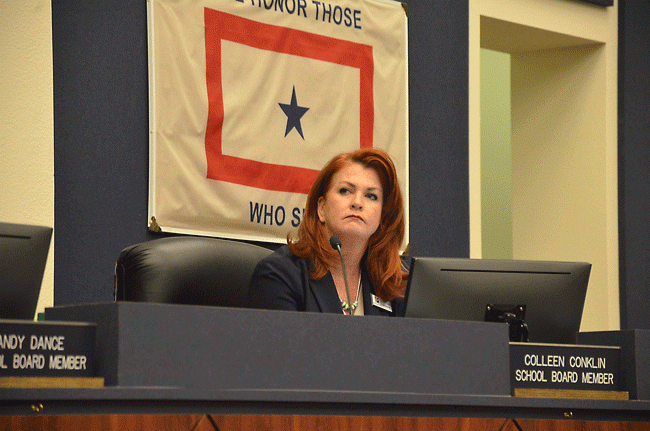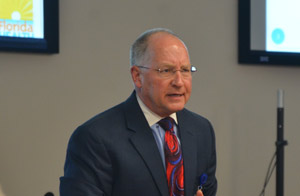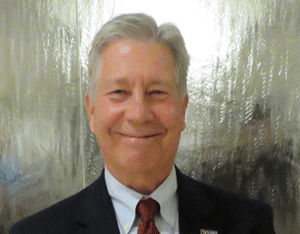
Flagler Health Department officials tried for the second time in three months to convince the school board to allow for voluntary HPV immunization of 6th graders. They fell a vote short during a 75-minute workshop segment with the school board that got tense at times.
School Board members Andy Dance and Trevor Tucker were supportive of the department’s initiative. Members Maria Barbosa and Janet McDonald, who also chairs the board, were not. Colleen Conklin was mostly on the women’s side but sought a compromise that kept her colleagues from rejecting the proposal altogether.
“I don’t want to kill this idea just yet, I’d really like to get some parental input,” Conklin said.
So the health department got a directive: go to School Improvement Councils and Parent Teacher Organizations, conduct an informational campaign, use the district’s own Community Problem Solvers if possible–if a team is willing–then report back to the board in October or November. If the campaign finds sufficient parental support, Conklin might lend her support to the voluntary immunization system, though she remains convinced that parents can get the vaccine for their children just as they do other vaccines: at their doctor’s office or even at the health department itself.
The health department does provide the vaccine, with an acceptance rate of more than 90 percent among parents who are offered the choice. But limiting it to the health department or private providers misses the point, Stephen Bickel, the department’s medical director and a physician, told the board. School-based immunization programs have been among the “dramatic” successes of public health in the past half century, being “amazingly effective at getting really high rates that not only protect the people who get the vaccines but people who don’t, from herd immunity,” he said.

(© FlaglerLive)
“What we have with HPV is we have an HPV epidemic,” he said. “80 million people affected with HPV.” The human papillomavirus causes 14 million cases a year (Bickel estimated 14,000 in Flagler), most of them showing no visible symptoms. It causes 31,000 cases of cancer per year, or about 10.5 in Flagler, and 3,500 deaths from cervical cancer a year.
“If I were to tell you, OK, we’ve got some lead in our water,” Bickel told the board, tapping into last week’s discovery that there was lead in water fountains at Bunnell and Wadsworth elementaries. “Nothing’s going to happen right now, but starting in 20, 30 years, if we don’t do something about this, we’re going to get 10 cases of cancer a year, and two deaths a year. You guys would be all over it, I presume.” There was no reaction from the board members. “Why doesn’t that happen with HPV? You know, it’s 20, 30 years down the road, there’s some vaccine fatigue out there, increased skepticism in the science. I’ve gone through the data four times now, and I can honestly say–I’m open to hear discussions–but I can honestly say this is not a controversial vaccine in the medical community. You can’t find articles in the New England Journal, JAMA, Preventive Medicine, that there’s controversies.”
The health department has had “excellent outcomes” from its immunization programs in schools, Department Director Bob Snyder told the board, whether it’s for the flu vaccine (which the district encourages because it cuts down on immediate absenteeism) or the t-dap vaccine. The department is looking to dovetail its HPV focus on that success.
“This to us is all about public health, it’s about public choice, cancer prevention, and most importantly, parental consent,” Snyder said. “This would not occur without parental consent, just like with the flu vaccine and t-dap.”
The HPV vaccine would be provided sixth graders in conjunction with the t-dap vaccine, so it would not be an additional imposition on the student’s time away from the classroom. Parents would receive a detailed informational form from the Centers for Disease Control (you can read the full contents here) and a consent form, just as they would for t-dap. If they choose to have the vaccine, the consent form is signed, along with a checklist that makes it clear to parents that might indicate that the child should not have the vaccine. That’s only one part of the check system. The health department also checks through a state computer database to ensure that the child has not already been vaccinated.
“We want to make sure that we’ve ruled out any possibility for error,” says Bonnie Welter, the department’s director of nurses. School Health Coordinator Stephanie Ear reviews every document in the office, speaks with parents who may have incomplete forms, and reviews the documentation at school. Once a child is immunized, a document is sent home certifying what vaccine has been administered, with local contact information should the child develop any complications.
“It sounds to me honestly like it’s people who don’t want to give it, coming up with every excuse possible to not give it.”
“To us this is about choice, it’s about parental consent, we’re not mandating anything, we’d be tickled pink if 50 parents approved and consented, or a thousand,” Snyder said.
But the health officials might have had the moral weight of commandments from Mt. Sinai in their hands: they were not going to convince a segment of the school board that doesn’t want to see the vaccine in schools. Barbosa was concerned about liability issues and what would happen in case side effects developed–a question that caused Welter to lose patience with her for a moment, though Welter caught herself.
“I hope you understand this isn’t about me, my personal me, it is about [being able] to know, to see what the parents want for their children,” Barbosa said. She asked if there’d been surveys of PTOs, for examples, to gauge what parents think–an idea that would seed the eventual compromise.
Exchanges got more tense between McDonald and Bickel. McDonald wanted the information provided so children could be vaccinated at the health department, not have an additional “thirty minutes out of the classroom.” Health officials repeatedly stressed that there would not be additional time away from class, and that it would likely only affect, at most, a couple of hundred of willing 6th graders.
That didn’t change McDonald’s point of view. At one point she suggested that the department was seeking to expand its immunizations because it made money on the deal–a preposterous suggestion even if the department’s immunization program is in part subsidized through the 1963 federal Vaccination Assistance Act: no one at the department, nor the department itself, is getting rich from immunizing children (as may be the likelier case with private providers or pharmaceuticals manufacturing the vaccines).
“It’s true, it’s may be a pain for the school board, for the schools,” to provide the vaccine, Bickel said.
“It’s not that it’s a pain, it’s an impact on instruction,” McDonald said.
“Well, it sounds like it’s minimal, it’s right when they get the t-dap.” Bickel, “so it’s not an extra visit.”
“I’m concerned of the overlap,” McDonald said.

“I don’t think so,” McDonald replied, “I don’t think we’re a health department, and truly your funds come from the amounts of vaccinations that you get. That’s part of the funding through the CDC. I understand how that works, and I appreciate the availability for inoculations, vaccinations for folks, but I think we need to do what’s mandatory here and give out information for our folks to seek it out at the places where, either at a doctor’s office where there’s a professional that can follow it through,” or at the health department. “We have a lot on our plate as far as ongoing health issues in our schools, I would like to keep it a little cleaner.” (McDonald misstated the source of the money for health department inoculations: a third of the money is from Medicaid, a third is from federal grants, and a third is from state grants, according to the Health Department. None is from CDC.)
Dance had sought to end the discussion if there was no consensus on the board to go forward. He declared his support for the initiative by speaking of personal experience. “As far as our family goes, we had the discussion early on with my two daughters and they both had the vaccine early on,” he said. “My one question would be, how early do you recommend starting with the information going out to parents, at what grade or age.” (Ages 9 to 11 are the preferred window.)
Conklin, too, spoke of personal experience–from both ends of the spectrum. “I personally lost a cousin under the age of 30 to cancer, cervical cancer,” she said, “way too young, and if this was around I’m sure that her family, my family and her and everybody else in the world would have appreciated that opportunity to have had something like that. With that said I had my own personal situation with my son who had, you know, an adverse reaction. We were one of those exempt families for the d-tap, t-dap, whatever it is. I worry about consent that happens and parents aren’t fully aware.” She made a distinction between an actual conversation between health officials and parents and just the signing of a form, which she does not consider sufficient.
“I’m comfortable with an informational campaign, but I would like to gather some parental input and feedback through SACs and PTOs would be a great way to do that,” Conklin continued, referring to school-based School Improvement Councils and Parent-Teacher Organizations.
The health officials agreed, though Bickel and Snyder were clearly deflated by the end of the meeting: Snyder’s profuse thanks to the board members were audibly wry. But he knew going in that he had a battle on his hands.





























Eva says
Wow, it is seriously time to revisit who is serving on this School Board. How hard is it to see we have an epidemic on our hands and a very safe solution? Inexplicable to hear the excuses! I sure hope parents get behind it, it would surely get this protection to more kids.
Mary Fusco says
Wow, 6th graders need protection from a sexually transmitted disease. Amazing that no one sees this as a societal problem. Thank God my children and grandchildren are grown.
Edith Campins says
We really are regressing to the dark ages. Do we need an epidemic to bring these people to their senses?
Bethechange says
School board members: do your due diligence! Vaccines have side effects. That is a given. But a little research at a reliable source (PLEASE skip the dot com sites!) would likely support the science that the benefits outweigh the risk, by far. I find myself cringing on a daily basis because of the paranoid mistrust of all things government-initiated. Dr. Bickel, l guess consider yourself lucky they didn’t slap an ankle bracelet on you and sentence you to house arrest. Ugh! Exhausting!
Florida Voter says
@Mary:
Some strands of HPV can be transmitted orally and are likely to cause maouth cancers. So Ignoring the 6th graders who might need protection from STDs since they are kissing, let’s push ourselves ahead 15 years and consider the people who will be 25 at that time.
One of the reasons that “ages 9 to 11 are the preferred window” is because the vaccine is most effective in children. Vaccinate the 10 year old now and in 15 years that person is protected.
Over 70% of cervical cancer is caused by HPV and the vaccine is 90% effective at preventing that cancer. This means that if we vaccinated the population, we could eliminate more than half (>60% actually) of all cervical cancer cases. HPVs also cause other cancers and other infections. We could prevent more than 25,000 cases of cancer.
Vaccinate your 6th grader NOW to significantly decrease cancers in the future.
Jon Netts says
Gee, with a little luck, maybe we can bring back smallpox! The anti-vaxers have done a remarkable job in restoring measles to an epidemic status. Is the human papilloma virus (HPV) next on the list?
I refer you to an article published in “Scientific American” many years ago titled: “A Study of the Anti-Scientific Attitude in America.” The gist of the article talks about the public reaction to a notice that a city in Massachusetts was planning to fluoridate its water supply. The media was inundated with complaints of “foul tasting water,” “goldfish and other pets dying,” “severe headaches’” “children vomiting,” etc. EVEN BEFORE any fluorine was added to the water!
As I read your article, the program proposed by the Health Department was to be VOLUNTARY! There is no need to delay implementation until an “informational campaign” can be instituted, or until “sufficient” parental support is obtained. JUST DO IT! Those parents who want their children vaccinated can so indicate; those who do not can likewise refuse the vaccine on behalf of their children.
The good news is that “herd immunity” may well protect the children of those parents who opt out.
Steve Robinson says
Unfortunately, we have yet to develop a vaccine to fight willful ignorance.
Debra Naughton says
I don’t understand why the SB has the final say on children’s health? If there is an initiative that can be supported within the system and can help save lives, the bare minimum you should be obligated to is to allow parents to make the choice. If you want to vaccinate, do so; if you do not want to vaccinate then don’t. So much energy being wasted trying to control other peoples right to make a decision.